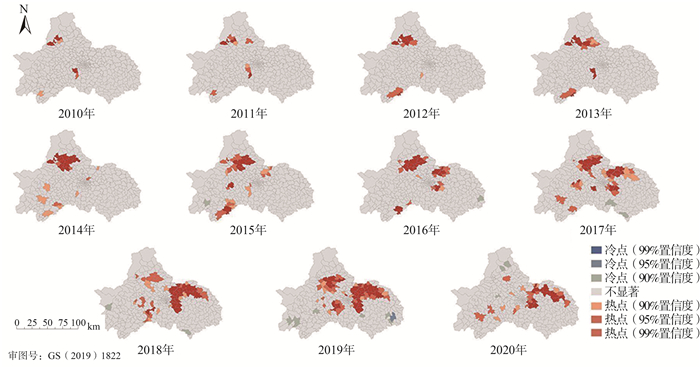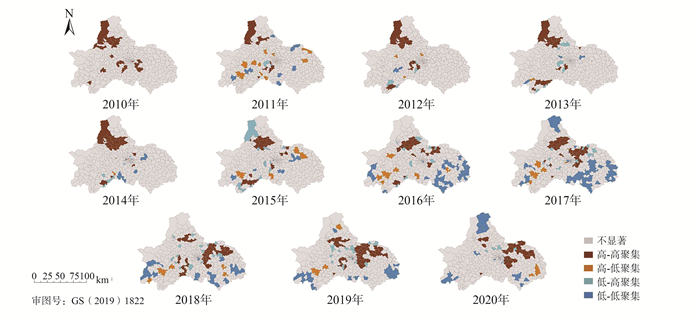Spatial clustering of HIV/AIDS cases aged 50 years and above in Chengdu from 2010 to 2020
-
摘要:
目的 分析2010―2020年成都市50岁及以上HIV感染者和AIDS病人(简称HIV/AIDS)的空间聚集性特征和趋势,为50岁及以上艾滋病的区域化防控及资源调整提供参考依据。 方法 从“中国疾病预防控制信息系统”筛选出2010―2020年成都市新报告的50岁以上HIV/AIDS并进行描述性分析,运用ArcGIS 10.6软件开展时空自相关分析及空间聚集性分析。 结果 成都市50岁及以上新报告的HIV/AIDS近11年年均增长率为28.95%,病例普遍以小学文化程度为主,占50.07%;已婚有配偶,占63.00%;职业为农民为主,占61.98%;异性传播,占95.72%。HIV/AIDS人数在区域范围内呈现聚集性分布,病例高-高型聚集区随时间推移:北部地区由西部两个区县逐渐向东扩散至四个区县,并向南扩散到周边两个区县;南部地区三个区县扩散至周边四个区县。 结论 2010―2020年成都市50岁及以上人群HIV/AIDS数持续增加,空间分布上呈现出明显的不均衡性,疫情较严重的区域集中在成都市中部偏北,随时间推移中部地区和东部地区的热点区域逐渐增多,并且呈现扩散趋势。 Abstract:Objective To explore the spatial clustering characteristics and trends of AIDS among HIV/AIDS cases aged 50 years and above in Chengdu from 2010 to 2021. And to provide a reference basis for regionalised prevention and control of AIDS. Methods HIV/AIDS cases aged 50 years or above in Chengdu between 2010 and 2020 were selected from China information system for disease control and prevention, and descriptive analysis was carried out. Moreover, spatial and temporal autocorrelation and spatial aggregation analyses were conducted using ArcGIS 10.6 software. Results The average annual growth rate was 28.95% over the last 11 years among HIV/AIDS cases aged 50 years and above in Chengdu. Of 50.07% AIDS aged 50 years and above have only received primary education, 63.00% were unmarried. 61.98% of cases were farmers. Heterosexual transmission accounts for 95.72% of cases. HIV/AIDS cases were in a pattern of aggregative distribution. Areas of high-high case were clustering over time. In northern region, high-high aggregation areas gradually spreads from two districts in the west eastwards to four districts and southwards to two adjacent districts. However in southern region high-high aggregation areas spreads from three districts to four adjacent districts. Conclusions The spatial distribution of HIV/AIDS cases among aged 50 years and above in Chengdu is not random, and there is spatial clustering. The high-value clustering area gradually develops from central northern regions of Chengdu to central and eastern regions. -
Key words:
- AIDS /
- Aged 50 years and above /
- Spatial autocorrelation /
- GIS system
-
我国的AIDS疫情形势不容乐观。随着我国逐渐进入老龄化社会,AIDS逐渐向老年人蔓延,该人群已成为我国AIDS的重点人群之一。全国AIDS疫情报告系统显示,2005―2016年全国每年新报告的HIV感染者和AIDS病人(简称HIV/AIDS),年龄在50岁及以上的比例从5.76%增加到41.23%,11年内增加了约7倍[1]。近年来有些地区50岁及以上AIDS报告数占总报告AIDS人数的比例已经超过了50%[2]。老年人群的AIDS疫情逐渐引起了社会的广泛关注。
四川省在全国范围来看属于高值聚集区域[3],成都市一直是我国AIDS防控的重点地区。由于AIDS具有聚集性分布的现象,且受地理、经济、文化、医疗水平等因素影响,各地疫情分布并不均衡。以往的研究[4]多通过聚类分析或者描述性分析对区县级的空间信息进行研究,很少基于乡镇街道尺度通过直观地理信息系统对聚集性区域进行探索和描述。
本研究首次提出基于乡镇街道尺度对成都市50岁及以上人群AIDS疫情空间聚集性特征及变化趋势进行探讨,为成都市AIDS重点人群的区域化防控及卫生资源配置提供依据。
1. 资料与方法
1.1 资料来源
从“中国疾病预防控制信息系统”中筛选现住址为成都市、录入时间为2010年1月1日―2020年12月31日和报告时年龄在50岁及以上的HIV/AIDS。成都市2018年矢量化乡镇/街道级地理电子地图来自“国家地理信息公共服务平台”。地区编码来源于“中国疾病预防控制信息系统”。
1.2 研究方法
(1) 全局空间自相关分析:计算每年的HIV/AIDS全局空间自相关的Moran’s I系数,在α=0.05的检验水准下,判断要素在区域内的聚集性是否有统计学意义[5]。(2)全局G统计量分析:G统计量是判断要素在区域内发生是高值还是低值聚集的分析方法。全局G统计量取值范围在0~1,统计量的检验以Genral G指数和期望指数的差值G*来判断。(3)局部空间自相关分析:聚类和异常值分析是通过计算每个空间单元的局部空间自相关Moran’s I系数,对其进行假设检验得到Z值,在α=0.05的检验水准下,研究区域与其相邻地区病例发病情况是否相似[6]。(4)热点分析:在地图上显示高值或低值聚集区域且探测范围较聚类和异常值分析更加灵敏[5]。若Z>1.96且P<0.05,则地图上呈现高值聚类(热点区域);若P<0.05且Z<-1.96,则地图上呈现低值聚类(冷点区域)。
1.3 统计学方法
采用SPSS 21.0软件对AIDS的流行特征进行描述性分析;运用ArcGIS 10.6软件处理成都市乡镇/街道级矢量电子地图,将病例的地址和电子地图对应的区域进行连接与关联,建立成都市2010―2020年50岁及以上人群AIDS空间地理信息数据库,进行时空自相关分析及热点分析。检验水准α=0.05。
2. 结果
2.1 成都市50岁及以上AIDS疫情概况
2010―2020年成都市共报告19 364例50岁及以上的HIV/AIDS。除2020年较上年人数有所下降外,其余每年报告人数均呈增加趋势,年均增长率为28.95%。2019年报告数最多,是2010年的15.71倍。其中男性14 450例(74.62%),女性4 914例(25.38%),男女性别比为2.94∶1。
2.2 一般人口学情况
2010―2020年新报告的19 364例HIV/AIDS:年龄主要集中在50~64岁,约占62.26%;汉族99.37%;文化程度以小学为主,占50.07%;婚姻状况以已婚有配偶为主,占63.00%;职业以农民为主,占61.98%;感染途径以异性传播为主,占95.72%;样本来源以其他就诊者检测为主,占55.41%。
2.3 50岁及以上AIDS疫情分布
成都市2010―2020年有366个乡镇/街道报告了50岁及以上HIV/AIDS,报告地区病例中位数为38例。报告病例数超过300人的乡镇/街道有2个:DS街道和CY街道,报告201~300例的乡镇/街道有9个:XD街道、LQ街道、XF街道、TP街道、HS街道、ZZ街道、TC镇、XF镇、PT街道,39个乡镇/街道报告病例数为100~200例,233个乡镇/街道报告病例数低于50例。
2.4 空间自相关分析
2.4.1 全局空间自相关分析
2010―2020年全市50岁及以上HIV/AIDS报告数全局自相关系数Moran’s I均在0~1,P值均小于0.001,说明AIDS病例数在区域范围内存在正向空间自相关,整体呈现聚集性分布。见表 1。
表 1 2010―2020年全局自相关系数和G统计量分析结果Table 1. Results of the analysis of Global Moran's I and Getis-Ord General for 2010-2020年份(年) 自相关系数 G统计量 Moran’s I值 Z值 P值 General G值 期望指数值 Z值 P值 2010 0.696 6.278 <0.001 0.023 0.008 3.250 0.001 2011 0.525 5.771 <0.001 0.025 0.007 4.765 <0.001 2012 0.424 6.283 <0.001 0.024 0.010 4.900 <0.001 2013 0.228 4.090 <0.001 0.020 0.013 3.368 <0.001 2014 0.322 6.163 <0.001 0.023 0.012 6.226 <0.001 2015 0.163 3.730 <0.001 0.019 0.011 6.240 <0.001 2016 0.174 4.144 <0.001 0.022 0.013 8.635 <0.001 2017 0.246 6.013 <0.001 0.023 0.013 9.583 <0.001 2018 0.227 6.180 <0.001 0.022 0.014 9.324 <0.001 2019 0.251 7.034 <0.001 0.023 0.014 10.700 <0.001 2020 0.185 3.822 <0.001 0.019 0.011 6.240 <0.001 2.4.2 全局G统计量分析
2010―2020年全市50岁及以上HIV/AIDS报告数全局G统计量指数均大于期望指数,P值均小于0.05,表明AIDS病例数在区域范围内相关关系差异有统计学意义。发病人数较高的地区较为集中,存在热点区域,即高值聚集现象。见表 1。
2.4.3 局部空间自相关可视化分析
进一步进行局部空间自相关分析,并通过ArcGIS 10.6软件将聚集性区域进行可视化呈现。通过聚类和异常值分析分别找出了每一年的高-高、高-低、低-高、低-低区域。结果显示成都市2010―2020年50岁及以上AIDS病例高-高型聚集区发展大致分为两个部分:(1)北方从西部的都江堰市、彭州市逐渐向东扩散至郫都区、新都区、青白江区、金堂县,并向南扩散到龙泉驿区、成华区。(2)南方从双流区、新津区、武侯区向四周扩散到蒲江县、邛崃市、锦江区、崇州市。2013年新增的高-高型聚集区域:郫都区、邛崃市;2014年新增的高-高型聚集区域:锦江区、新都区;2016年新增的高-高型聚集区域:龙泉驿区;2017年新增的高-高型聚集区域:崇州市、金牛区;2018年新增的高-高型聚集区域:金堂县,在往年的高-低型/低-高型区域均有提示。见图 1。
进一步的热点分析显示,截至2020年底,Gi*值>1.96, P<0.05的乡镇/街道有26个,分别为:金堂县(ZZ街道、GB镇、HK镇、BG镇、SX镇、ZH镇)、青白江区(QQ镇、YD镇、DW街道、XF镇、LW镇)、龙泉驿区(DM街道、LQ街道、XH镇、SL街道)、新都区(TX镇、ML镇、SH街道)、成华区(BH街道、LT街道)、双流区(HJ街道)、彭州市(LC镇)、崇州市(LY乡)、锦江区(SS街道)、邛崃市(LQ镇)、大邑县(AR镇),呈高值聚集区域。见图 2。
3. 讨论
随着遥感等技术和全球定位系统的不断发展,地理信息系统(geographic information system, GIS)以及空间统计学越来越多地被运用于AIDS防控工作中[7-8]。研究发现2010―2020年成都市50岁及以上HIV/AIDS病例数持续增加,时空分析显示病例在空间上存在聚集性及热点区域,本研究首次从乡镇层面对成都市50岁以上AIDS疫情发展开展空间聚集性分析,为今后重点区域的监测和针对性干预措施的开展提供参考。
成都市近几年新报告50岁及以上AIDS例数增长较快,其原因除了此年龄段人群感染HIV的人数较多以外,还包括采取的以下三个扩大检测覆盖面的策略:(1)本地医疗机构全面落实医务人员主动提供艾滋病检测咨询(provider-initiated HIV testing and counseling, PITC)策略,50岁及以上人群在就诊时会检测HIV,对该人群的发现来源分析也提示医疗机构就诊成为该人群被发现的主要来源[9]。(2)成都市逐步健全全市AIDS检测网络,基层卫生医疗机构基本都具备HIV筛查能力,2017年起结合基本公共卫生服务中的老年人慢性病体检、社区居民健康档案建立以及女性三病筛查等项目,增加对服务对象免费AIDS检测,让更多感染了HIV的人被发现[10]。(3)2018年对成都市AIDS疫情进行科学研判后,将45~65岁男性作为AIDS的重点筛查人群,基层卫生医疗机构主动对辖区居民中该类人群开展HIV筛查。通过以上一系列举措使得更多的感染者被发现。2020年较上年度新发现人数减少,可能与COVID-19疫情居民外出减少、就医行为减少以及疫情期间医疗卫生资源配置有关[11]。
AIDS的分布具有很强的空间特性,容易受地区的经济和人文环境影响[12]。2014年以前50岁以上AIDS疫情在成都市的东北部地区呈现聚集性。该地区中以都江堰市为例:它是成都市发现AIDS病例较早的区县之一,作为一个旅游城市,存在大量低档暗娼场所,而近几年暗娼哨点监测也发现该地区暗娼阳性率远高于本市其他区县。此外,该地区与少数民族自治州接壤,人口流动性大,以农村地区为主,文化层次普遍偏低。2015年50岁以上人群AIDS疫情逐渐向中部地区转移,聚集区进一步增加,中东部地区呈现出较明显的聚集性,原因可能受成都市政府近年来的“东进战略”以及国家规划的“成渝地区双城经济圈”的影响,东部地区加快了城市化进程,经济水平提升让一部分本地农民发生商业性行为的机会增加。另外,大量的建筑工地、建设中的大型的物流中心和工业园区带来的增量流动人口,也会带动当地低档暗娼场所的兴起。成都市中部地区和东部地区的热点区域逐渐增多,并且呈现扩散趋势。50岁及以上人群的疫情近年来也表现出向辖区内其他区县扩散的趋势,防控压力增大。
综上,成都市50岁及以上AIDS呈快速增长趋势,老年人成为AIDS的重点防控人群之一。空间自相关揭示近11年成都市50岁及以上AIDS病例在地理空间分布上存在聚集性,高值聚集区域发展分为南北两部分。相邻区域的AIDS疫情差异性在降低,AIDS由个别区域向全域扩散。应重点加强主城区和邻近二圈层城乡结合部热点区域的中老年人群和低档暗娼人群AIDS的干预力度,针对“低―低”型聚集区域要重点防范周边疫情高发区域的病例流入而引起疫情上升。同时人口流动性大意味着可能存在更多的高危性行为,需要加强对流动人口的宣传教育工作[13]。
-
表 1 2010―2020年全局自相关系数和G统计量分析结果
Table 1. Results of the analysis of Global Moran's I and Getis-Ord General for 2010-2020
年份(年) 自相关系数 G统计量 Moran’s I值 Z值 P值 General G值 期望指数值 Z值 P值 2010 0.696 6.278 <0.001 0.023 0.008 3.250 0.001 2011 0.525 5.771 <0.001 0.025 0.007 4.765 <0.001 2012 0.424 6.283 <0.001 0.024 0.010 4.900 <0.001 2013 0.228 4.090 <0.001 0.020 0.013 3.368 <0.001 2014 0.322 6.163 <0.001 0.023 0.012 6.226 <0.001 2015 0.163 3.730 <0.001 0.019 0.011 6.240 <0.001 2016 0.174 4.144 <0.001 0.022 0.013 8.635 <0.001 2017 0.246 6.013 <0.001 0.023 0.013 9.583 <0.001 2018 0.227 6.180 <0.001 0.022 0.014 9.324 <0.001 2019 0.251 7.034 <0.001 0.023 0.014 10.700 <0.001 2020 0.185 3.822 <0.001 0.019 0.011 6.240 <0.001 -
[1] 中华人民共和国卫生部, 联合国艾滋病规划署, 世界卫生组织. 2011年中国艾滋病疫情估计[J]. 中国艾滋病性病, 2012, 18(1): 1-5. DOI: 10.13419/j.cnki.aids.2012.01.005.Ministry of Health People' s Republic of China, UNAIDS, WHO. Estimation of AIDS epidemic in China, 2011[J]. Chin J AIDS STD, 2012, 18(1): 1-5. DOI: 10.13419/j.cnki.aids.2012.01.005. [2] 高良敏, 付金翠, 李世福, 等. 50岁以上人群HIV流行特征与相关危险因素的系统性分析[J]. 皮肤病与性病, 2016, 38(1): 36-42. DOI: 10.3969/j.issn.1002-1310.2016.01.013.Gao LM, Fu JC, Li SF, et al. Systematic analysis of HIV prevalence characteristics and associated risk factors among people aged 50 years or above[J]. J Dermatol Venereol, 2016, 38(1): 36-42. DOI: 10.3969/j.issn.1002-1310.2016.01.013. [3] 王莹. 2013年中国HIV/AIDS空间分布及主要社会经济影响因素[D]. 郑州: 郑州大学, 2016.Wang Y. Study on spatial distributions and socio-economic influence of HIV/AIDS in the people's republic of China in 2013[D]. Zhengzhou: Zhengzhou University, 2016. [4] 施雅莹, 练建, 段振华, 等. 成都市2015-2018年艾滋病流行特点及空间聚类分析[J]. 中国艾滋病性病, 2020, 26(10): 1076-1079. DOI: 10.13419/j.cnki.aids.2020.10.12.Shi YY, Lian J, Duan ZH, et al. The epidemic characteristics of HIV/AIDS in Chengdu during 2015-2018[J]. Chin J AIDS STD, 2020, 26(10): 1076-1079. DOI: 10.13419/j.cnki.aids.2020.10.12. [5] Peng ZH, Cheng YJ, Reilly KH, et al. Spatial distribution of HIV/AIDS in Yunnan Province, People's Republic of China[J]. Geospat health, 2011, 5(2): 177-182. DOI: 10.4081/gh.2011.169. [6] 张松林, 张昆. 局部空间自相关指标对比研究[J]. 统计研究, 2007, (7): 65-67. DOI: 10.19343/j.cnki.11-1302/c.2007.07.013.Zhang SL, Zhang K. Contrast study on the local indices of spatial autocorrelation[J]. Statistical Research, 2007, (7): 65-67. DOI: 10.19343/j.cnki.11-1302/c.2007.07.013. [7] 朱勇, 周超, 贺学俊, 等. 基于空间自相关和时空扫描统计量的重庆市荣昌区HIV/AIDS病人聚类研究[J]. 中国热带医学, 2021, 21(4): 343-348. DOI: 10.13604/j.cnki.46-1064/r.2021.04.09.Zhu Y, Zhou C, He XJ, et al. Autocorrelation and spatiotemporal clusters of HIV/AIDS patients in Rongchang District, Chongqing[J]. China Tropical Medicine, 2021, 21(4): 343-348. DOI: 10.13604/j.cnki.46-1064/r.2021.04.09. [8] 唐仁海, 李仕祯, 杨跃诚, 等. 2010-2018年德宏州HIV新近感染者的时空特征分析[J]. 中国艾滋病性病, 2020, 26(11): 1182-1186. DOI: 10.13419/j.cnki.aids.2020.11.10.Tang RH, Li SZ, Yang YC, et al. A spatial analysis on HIV recent infection in Dehong prefecture from 2010 to 2018[J]. Chin J AIDS STD, 2020, 26(11): 1182-1186. DOI: 10.13419/j.cnki.aids.2020.11.10. [9] 鹿茸, 施雅莹, 段振华. 2010-2014年成都市50岁及以上男性艾滋病疫情分析[J]. 预防医学情报杂志, 2016, 32(11): 1137-1139. https://www.cnki.com.cn/Article/CJFDTOTAL-YFYX201611003.htmLu R, Shi YY, Duan ZH. The HIV/AIDS epidemic of men aged 50 and older in Chengdu, 2010-2014[J]. J Prevent Med Inf, 2016, 32(11): 1137-1139. https://www.cnki.com.cn/Article/CJFDTOTAL-YFYX201611003.htm [10] 梁莉, 刘莉, 裴晓迪, 等. 2008-2011年四川省艾滋病HIV检测分析[J]. 预防医学情报杂志, 2013, 29(6): 453-456. https://www.cnki.com.cn/Article/CJFDTOTAL-YFYX201306007.htmLiang L, Liu L, Pei XD, et al. Detection on HIV in Sichuan Province, 2008-2011[J]. J Prevent Med Inf, 2013, 29(6): 453-456. https://www.cnki.com.cn/Article/CJFDTOTAL-YFYX201306007.htm [11] 袁风顺, 刘莉, 刘伦皓, 等. 四川省2020年1季度HIV/AIDS病例报告与新冠肺炎疫情相关性分析[J]. 中国艾滋病性病, 2020, 26(11): 1178-1181. DOI: 10.13419/j.cnki.aids.2020.11.09.Yuan FS, Liu L, Liu LH, et al. Correlation between coronavirus disease 2019 and HIV/AIDS case reporting in the first quarter of 2020[J]. Chin J AIDS STD, 2020, 26(11): 1178-1181. DOI: 10.13419/j.cnki.aids.2020.11.09. [12] Shasha Q, Wei G, Jiannan X, et al. Diversity of HIV/AIDS epidemic in China: a result from hierarchical clustering analysis and spatial autocorrelation analysis[J]. AIDS, 2014, 28(12): 1805-1813. DOI: 10.1097/QAD.0000000000000323. [13] 罗映娟, 赖文红, 裴晓迪, 等. 2012-2015年四川省流动人口艾滋病哨点监测结果分析[J]. 预防医学情报杂志, 2018, 34(5): 594-597. https://www.cnki.com.cn/Article/CJFDTOTAL-YFYX201805013.htmLuo YJ, Lai WH, Pei XD, et al. Analysis of HIV sentinel surveillance results among the floating population in Sichuan Province from 2012 to 2015[J]. J Prevent Med Inf, 2018, 34(5): 594-597. https://www.cnki.com.cn/Article/CJFDTOTAL-YFYX201805013.htm 期刊类型引用(3)
1. 刘晟,周丙锋,谢新水,刘姗姗. 中国HIV/AIDS发病率时空分异和宏观影响因素研究. 现代预防医学. 2024(01): 1-7 .  百度学术
百度学术2. 张静航,高守芝,郑军,陈曦,贺健梅. 基于Joinpoint回归模型的2004-2022年湖南省梅毒流行趋势分析. 中国艾滋病性病. 2024(03): 299-302 .  百度学术
百度学术3. 施雅莹,朱彦锋,周子慧,刘芳,徐菁佩,代珍,王亮. 2010—2021年成都市新报告MSM艾滋病人群的空间聚集性分析. 现代预防医学. 2024(19): 3489-3494 .  百度学术
百度学术其他类型引用(3)
-





 下载:
下载:



 下载:
下载:



